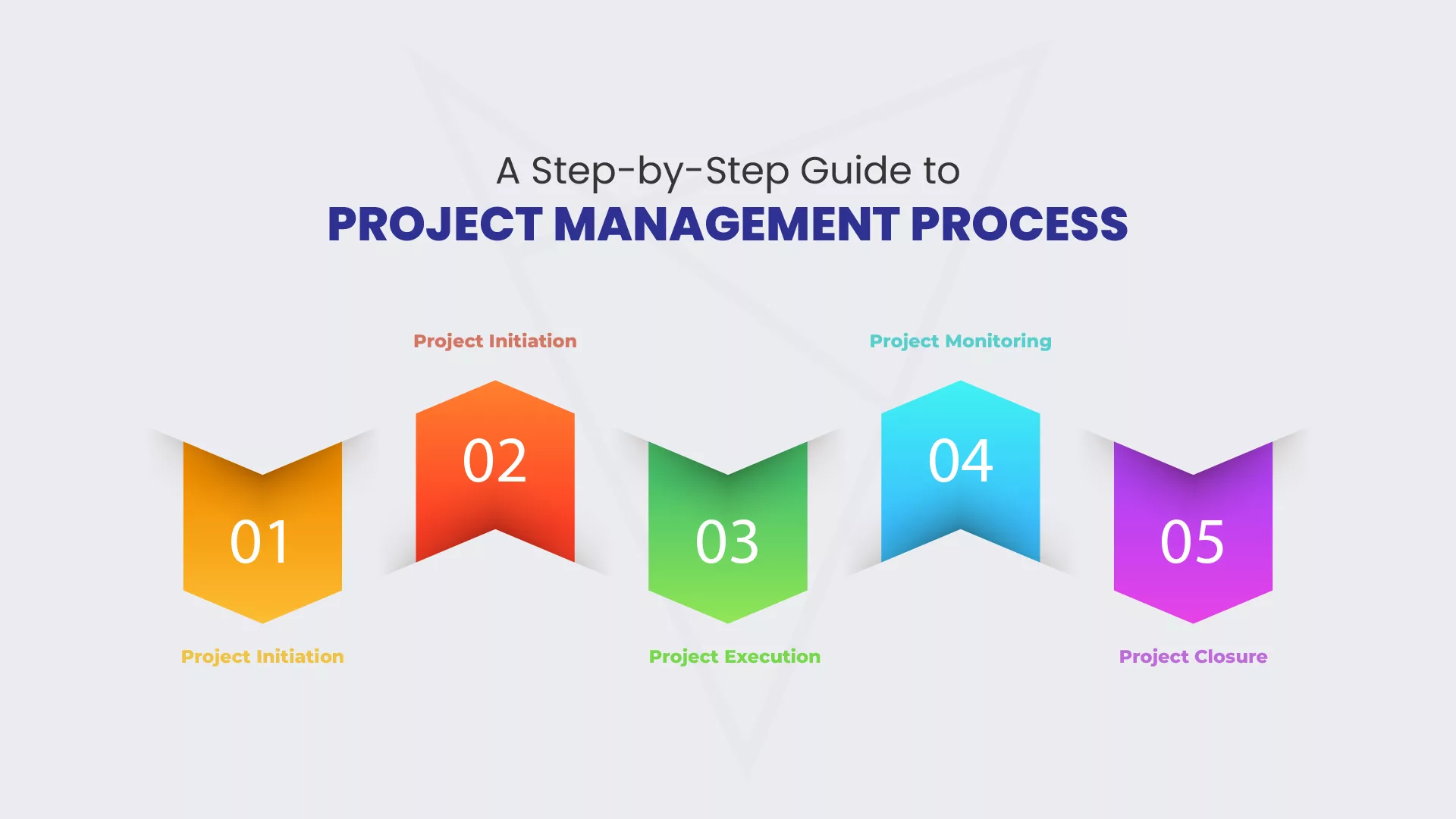A smart project management process is the need of the hour. Studies confirm that 77% of businesses are successful in meeting their desired goals when applying a systematic approach.
Apparently, one of the reasons for failure in project management is avoiding the project management process. Today we are here with a step-by-step guide to the project management process.
This article will walk you through the detailed and successful guidelines for a smooth project management process. So, you can use it, maintain your budget and complete one on the decided deadline.
5 Simple Steps of the Project Management Process

Project Initiation
Project initiation is the first step of the project management process. In this first stage, you need to put insights into a project and highlight the aims you have with it.
First of all, answers question like what you want to achieve with the specific project. Identify the goal and have a clear vision toward the finish line.
In this phase, you must consider three things: the business case, the project charter, and approval from stakeholders.
Business Case
A business case is basically a document in which you prove a project’s need for your client’s business. It has details on the project objectives as well as the Return On Investment a project can bring in.
This business case involves a well-thought-out process, including design and implementation.
Project Charter
After the business case, one of the most significant documents that you need to have in this project management process model is the project charter.
Although short, this document contains 6 specific details:
- Overview: The importance of the project and your plans for making it successful.
- Outline of Scope: The results you want to achieve with it.
- Timeframe: An estimated time on which the project is expected to complete.
- Budget: Bucks this specific project will require and the resources you will use out of it.
- Risk: Defined areas for risk and uncertainties that can occur.
- Key Stakeholders: People associated with the specific project.
Remember that the project charter doesn’t include IT information.
Stakeholder’s Approval
The stakeholder is everyone working on the project. So, once your project charter and the business case are ready, you’d need to discuss them with the stakeholders. If they are satisfied with the initial proposal and give you the green flag, you can start project planning immediately.
Project Planning
Project planning is the follow-up step of the project management process. Here you will not only plan the project but allow your stakeholders to understand their role in the entire process.
What you plan in this stage will be implemented in the next stages. Planning the right strategy while keeping external factors in mind is really important, that’s why. So, make sure you plan all of the following efficiently.
Work Breakdown Structure (WBS)
Work breakdown structure answers the “what” of your project. With its help, you visualize your project’s practicality and prioritize tasks.
Project Goal
Your goals will decide the direction you need to move on. So, make sure the approach you are picking is right for the project considering the requirement of your project.
Usually, there are two methods for project goals: S.M.A.R.T and C.L.E.A.R. The S.M.A.R.T. method will help you mitigate risks and ease the path to the project’s success. C.L.E.A.R. method keeps pace with the modern world’s needs.
Project Budget
The budget of the project includes the cost of every small expenditure. It will have details on what tools you’ll be using and help you eliminate unnecessary tools and expenditures. So, you stay within the budget, besides having every vital tool at your disposal.
Project Risk Management
Regardless of the size of the project, risks are there. Technology change can be one of the biggest risks, for instance. You must be prepared for these rising risks so the situation stays under control.
Stakeholder Management Plan
Keep in mind the stakeholders of the project and pick a communication channel for exchanging the details smoothly. So there stays no confusion, and the project process is completed easily.
This stage of the project management process is the most time-consuming. However, if done right by paying attention to details, you’re halfway to success.
Must Read: 12 Surefire Ways to Boost Your Project Management Skills
Project Execution
The execution phase of the project management process is equal to the time for action. In this stage, you will implement the plan you have designed in the stage above.
Before that, you’d need to arrange a “kick-off meeting.” This meeting is set up between you and your client. Its purpose is to introduce your team members working on the project.
Not only this, you share details on the plan and strategies for the project’s success in this meeting. So both your client and the team better understand the project.
Primary Tasks in the Execution Phase
Although there are tons of tasks you’d be dealing with in this phase, here are just a few of them:
- Forming and introducing the members who’d work on the project
- You’ll also provide necessary resources for the project to the team so they can get started
- Additionally, you’ll brief the details, roles, and expectations of the team
- Setting up communication and tracking systems will also take place in this stage
Further tasks include updating schedules and plans – if you feel a need.
Project Monitoring
Project monitoring and project execution go hand in hand. That said, you need to keep track of and monitor the progress of your project along with executing it.
In this phase of the project management process, you’d see if every team member is following the plan or not. Monitoring and control over a project are necessary if you want to complete the project with accuracy and efficiency.
Must Read: Which Project management software is the right fit for your team?
Common Key Performance Indicators
Monitoring the project process is based on the Key Performance Indicators (KPIs) you pick for the project. Usually, the following are the primary KPIs project managers idealize:
- Budget: The first thing you’d be considering is cost. To stay and complete the project within the budget is the primary goal. Check if the expenditure is balanced and the project will complete with it.
- Quality: Keep your team in the loop with you. Know if they are following the guidelines right. You need to make sure they stick to the requirements and follow the given set of guidelines.
- Timeframe: Besides keeping track of budget and quality, you need to make sure the pace of the project is exactly as planned. So your project will be completed on time and with accuracy.
- Performance: By tracking the performance of your team members and their use of resources, you can determine if they are on the right track. This check-up will also let you know if problems are occurring. So you can find a quick and possible solution.
You can also add more KPIs to this depending on the type and nature of your project. However, monitoring is crucial for efficient results.
Project Closure
It’s time to celebrate and appreciate your team since now your project is completed. Deliver the completed project to the stakeholders. However, there’s still some work left to be done, and it is as follows:
Documenting Project Closure
Stamp “completed” your project after giving the file to your stakeholder. Make sure to acknowledge him about the delivery so that he knows and can check it out.
Performance Evaluation
Analyze if the project is completed with all the details followed and if there are any pitfalls.
Analysis of Team’s Performance
Give a thorough check-up on every team member’s performance on the specific project. This will highlight the keenest worker you can deploy on the next project. Also, the one you should pick the least in the next project.
Post Mortem of the Project
After delivery, this would be the final analysis of the project. Here you’d need to pay attention to the reasons for the success and failures of the project – if any.
Budgeting Recheck
Clear everyone’s payment in your team. This will help you gain their trust for the next project. Additionally, document if money from the decided budget is left and return it.
Although the project is completed as a project manager, this financial information can help you perform better – if not the best – in the next project. It will keep you from repeating the same mistake.
Conclusion
There are 5 steps of a project management process, starting from the initiation step. Next is to plan your project. Here you’ll dive deep and strategize everything from project deadlines to risk management.
Once you are done with planning, initiate working on it. This step is called execution while you monitor the progress along with it, and the process is called project monitoring.
Finally, the last step of project closure comes when you wind up the work, submit it to the client, and evaluate the performance to perform better in the future. Follow this project management process if you want to complete projects on time with accuracy and stay within the decided budget.
Must Read: 15 Best Agile Project Management Software’s for your Teams



